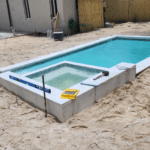Who has never dreamed of having a pool at home to enjoy the hot days?
Install a fiberglass pool in your backyard can be a hard work to do if you choose the wrong professionals to do the job. Despite the many doubts that accompany this desire – such as the costs, materials and labor required for the installation – enjoying a bath in clean, fresh water without leaving home is a plan that can become a reality with planning and attention.
What was once considered a luxury item, today can be affordable due to the variety of sizes and models of products found on the market. Pools made of fiberglass are the most popular. They started to be manufactured in 1950, with the same material that the boats were made of, due to its great durability and for withstanding changes in the environment, such as temperature and pressure.
Its cost is lower than pools made with tiles and the excavation is usually done by the company that manufactures the product, which makes the investment more affordable. It takes between 10 and 15 days for the installation to be completed – in cases where the choice of mold is compatible with the desired location for the installation. But watch out! Even with such ease, some details and care must be observed. It is essential to hire a trained and experienced professional and, of course, use quality materials in the work!
The professional installing the fiberglass pool must know well about electrical and hydraulic equipment so as not to place the pump and filter in the pool the wrong way, in addition to correctly implementing the lighting, avoiding accidents.
How to install a fiberglass pool?
Know the installation process, so it is easier to understand the advantages and ensure the best use of your fiber pool.
1. Positioning and Marking
This is the time to also choose the best position of the pool in relation to the sun. The most suitable place is the highest one, where rainwater does not flow into the pool. The first step is to mark and remove the square from the place where the pool will be installed.
2. Excavation of the land
After marking, the excavation of the land begins. The width of the hole should be about 30cm wider than the walls of the pool. The excavation of the pool hole must be complete and finished.
3. Concreting of the base
Start concreting the base. It is necessary to make a smooth (burnt) floor of 10 cm high, well leveled. Some installers make a 5cm sand mattress between the floor and the pool, which is not wrong. However, we advise placing the pool directly on the concrete base. This will make leveling easier during installation.
In addition, during use, there is no rippling sensation on the bottom of the pool for those who are walking inside it.
4. Positioning
Place the pool in the hole, make sure there are no stones or dirt under the pool. Drill the hole for the engine room and the plumbing in the pool. Place water up to approximately 10 cm high inside the pool, so that the weight of the pool prevents any object (or dirt) from getting under it during the installation process.
Place a dry mixture of sand and cement around the pool in a ratio of 7 to 1. It is very important that this “farofa” is placed as the pool fills with water.
When the water inside the pool is 20 cm high, place 20 cm of “farofa” around the pool. When the water is 40 cm high inside the pool, put 40 cm of “farofa” around it. And so on, going up the “farofa” layer until it reaches the edge.
5. Time to install a fiberglass pool!
Your fiberglass pool is almost installed. To complete the process, we need to install the filter unit. The installation process is very simple and must be done by trained professionals.
6. Finishing the subfloor
The sub-floor* must be ready, waiting for the placement of the decorative stones as soon as possible. In order to prevent infiltration from rainwater.
Fiberglass pool care!
Due to the characteristics of the coating, fiberglass pools cannot be emptied without shoring the walls, as there is a risk of breaking or cracking when dry and unsupported. Whenever you need to empty it, contact specialized services.
Fiber pool paint is sensitive to direct contact with chemicals. Therefore, chlorine and algaecides – which prevent the proliferation of algae – must be well diluted before being mixed in the water.
In addition, it is also important to use specific waxes and cleaning products to maintain shine, durability and protection from the sun (sunrays dry out the pool lining and can cause cracks). It is also necessary to measure the total alkalinity of the water once a month and the pH twice a week.
With these care and instructions, maintaining a fiberglass pool at home is a pleasant and durable investment.
Check other blogposts here:

Your Complete Guide to Preparing for Pool Season
When entering the summer season our expectations of an amazing summertime is always full of moments of joy and love. To guarantee your perfect summer

Swim Like a Pro: Tips and Techniques to Improve Your Stroke
Having a pool at home not only offers endless fun but also presents an opportunity to refine your swimming skills

Transform your pool into a therapeutic resource
Have you ever considered the possibility of transforming your pool into a therapeutic resource? Hydrotherapy is a practice that combines physiotherapy techniques with the benefits

Pool and outdoor space design trends for 2024
Having a pool at home brings many moments of relaxation and joy. Furthermore, a designed pool can bring sophistication and add value to your space,

